World Wetlands Day : Everything You Need to Know About NC Wetlands

From the Blue Ridge Mountains to the sandhills to the coastal plain, North Carolina boasts a variety of ecosystems, and positioned throughout these regions are some of the state’s most biologically diverse habitat types: wetlands.
Many people do not realize the importance of wetlands to our state’s plants, fish and wildlife, and humans. In addition to providing food, water, cover, and areas for reproduction for a vast majority of species, more than 70 percent of North Carolina’s species listed as endangered, threatened, or of special concern depend on wetlands for survival (North Carolina Wetlands).
Like many of the natural spaces within North Carolina and beyond, wetlands are in danger of being detrimentally impacted or even destroyed by habitat destruction, degradation, and fragmentation. NCWF is committed to being a voice for these habitats and the fish and wildlife they support. In celebration of World Wetlands Day, here is a breakdown of what wetlands are, some of the wildlife that benefit from them, and what you can do to help protect them.
What Are Wetlands?
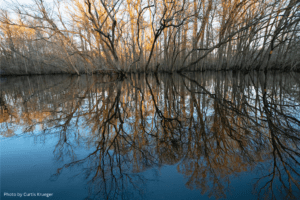 Wetlands are areas where water covers the soil for at least part of the year, encouraging the growth of wetland-specific plants (called “hydrophytes”) and soils (called “hydric soils”). Whether grasses or trees, hydrophytes can and must live without oxygen for periods of time, given that their roots are submerged in highly saturated hydric soils. The presence of these nutrient-rich hydric soils typically means that an area was once a wetland, even if it does not currently appear to function as one.
Wetlands are areas where water covers the soil for at least part of the year, encouraging the growth of wetland-specific plants (called “hydrophytes”) and soils (called “hydric soils”). Whether grasses or trees, hydrophytes can and must live without oxygen for periods of time, given that their roots are submerged in highly saturated hydric soils. The presence of these nutrient-rich hydric soils typically means that an area was once a wetland, even if it does not currently appear to function as one.
Not all wetlands may appear wet, which can make them difficult to identify. Many people expect to see vast amounts of open water when looking at a wetland – such as a cypress swamp, which has standing water nearly year-round. However, some valleys and creek bottoms only become wet during rainy seasons, or when nearby bodies of water flood into these natural, low-lying areas.
Wetland habitats occur throughout the state and are not relegated to coastal environments; however, the appearance and function of individual wetlands may vary from region to region, and may provide different forms of wildlife habitat. Though there are many variations of wetlands in North Carolina, they can generally be categorized as riverine forest wetlands, mountain bogs, Carolina bays, pocosins, seep wetlands, basin wetlands, pine wetlands, freshwater marshes, tidal freshwater marshes, salt/brackish marshes or estuarine woody wetlands.
Many of these wetland types form where sloping or mountainous terrain meets the floodplain of larger bodies of water. Runoff from higher elevations results in the transfer of soil and plant matter, creating unique habitat types for some of North Carolina’s most unique and even endangered plant and animal species. These species include the mountain sweet pitcher plant and endangered bog turtle in mountain bogs, the 2,000+ years old bald cypress trees in the riverine forest wetland of the Three Sisters Swamp, and various species of reptiles and amphibians which rely on Carolina bays, seeps, and basin wetlands to escape predators and maintain their reproductive cycles.
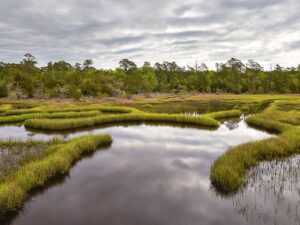 Wetlands like tidal freshwater marshes and brackish marshes are vital to aquatic species, particularly along the coast where these wetlands foster some of the most critical nursery habitat for fish and shellfish in the state, and they provide food for wading birds. Beyond their use as habitat for wildlife, these wetland environments have a myriad of other environmental benefits, such as functioning as shock absorbers during coastal storms and as filtering systems for harmful chemicals and storm runoff.
Wetlands like tidal freshwater marshes and brackish marshes are vital to aquatic species, particularly along the coast where these wetlands foster some of the most critical nursery habitat for fish and shellfish in the state, and they provide food for wading birds. Beyond their use as habitat for wildlife, these wetland environments have a myriad of other environmental benefits, such as functioning as shock absorbers during coastal storms and as filtering systems for harmful chemicals and storm runoff.
Despite the presence of wetlands providing numerous benefits to wildlife and people, many wetlands have already disappeared as a result of habitat destruction and land use changes. According to North Carolina Wetlands, only 20 percent of North Carolina’s prehistoric bogs still exist in their unaltered condition, with 80 percent altered by ditching or filling, typically for agricultural purposes. Pocosins, which originally covered much of the eastern third of our state, have been converted to agricultural land, and many pine wetlands have been transformed into pine plantations.
Wetlands – Wildlife’s Bed and Breakfast
Wetlands can be viewed as cafeterias for wildlife. The high diversity of plant and animal life makes for a full food web with unique environments for niche species. While some species only visit wetlands for a meal or a place to rest, others spend their entire lives there.
Fish:
North Carolina’s wetlands, particularly those on the coast, are important nursery grounds for finfish and shellfish. Some fish species lay their eggs and have their young grow up in shallow areas with high plant density, where they are protected from larger marine predators.
Invertebrates:
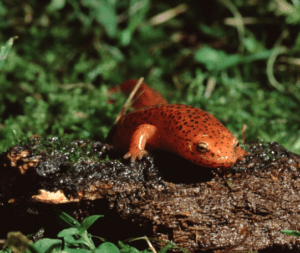 Many types of insects, worms, and crustaceans depend on wetlands because of the highly saturated environments and the availability of dead plant material for food. These invertebrate species are crucial to the wetland food web and are common food sources for fish and wildlife.
Many types of insects, worms, and crustaceans depend on wetlands because of the highly saturated environments and the availability of dead plant material for food. These invertebrate species are crucial to the wetland food web and are common food sources for fish and wildlife.
Vertebrates:
Amphibians such as salamanders, frogs, and toads rely on wetlands for food and safe areas to raise their young. North Carolina boasts over 90 species of amphibians, and they need wetlands for laying eggs, getting water in dry spells, and finding food.
Reptiles:
Lots of turtles, like the yellow bellied slider and the painted turtle, spend time in wetlands. Snakes and alligators may also call North Carolina wetlands their home, where they have easy access to emerging amphibians, a variety of fish, and even watering mammals as food sources.
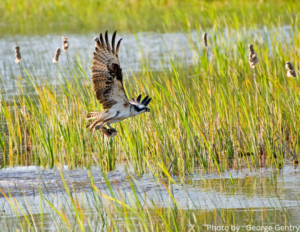 Birds:
Birds:
Birds rely on wetlands as a major food source. Wetlands provide a diverse menu of fish, amphibians, reptiles, and small mammals, as well as a plethora of nesting sites for birds of prey, such as eagles and hawks, and birds like herons.
Mammals:
While many mammals such as otters, beavers, and raccoons often use wetlands as their home terrain, other species like deer, bobcats, and coyotes use wetlands as a form of escape cover or hiding place from other predators and can regularly be spotted making use of wetland resources.
Hope for North Carolina Wetlands
As a voice for wildlife and habitat in North Carolina, NCWF is dedicated to protecting all forms of wildlife habitat – including wetlands.
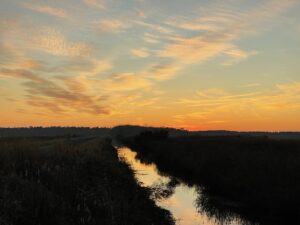 Our goal is to protect and restore the quality and function of our waters, wetlands, nurseries, and riparian areas so they can sustain healthy fish and wildlife populations. NCWF has been involved in water and wetlands work for many years and engaged in litigation and policy work when attacks on bedrock rules protecting these areas have occurred.
Our goal is to protect and restore the quality and function of our waters, wetlands, nurseries, and riparian areas so they can sustain healthy fish and wildlife populations. NCWF has been involved in water and wetlands work for many years and engaged in litigation and policy work when attacks on bedrock rules protecting these areas have occurred.
As 2022 wound down, new Rules were issued under the current Administration reinstating longstanding clean water protections that were in place prior to 2015 for traditional navigable waters. As a result, the new Rules protect many critical waterways that were previously protected for decades.
The Rule also sets forth exclusions for certain waters and features that have generally been considered outside the scope of “waters of the United States.” Under the new Rule, many waters that lost protections under the previous ruling-ephemeral streams, many wetlands, and other intrastate waters-will be protected if they, either alone or in combination with similar waters in the region, significantly affect traditional navigable waters, the territorial seas, or interstate waters. As the state develops at a rapid pace, protecting these water systems is critical.
How You Can Help
Though there is much work to be done to protect North Carolina’s wetlands, there are also steps you can take to make a positive impact on these natural spaces.
Control and report spills
- Spills or leaks naturally move downhill toward lower elevations where many wetlands exist. It is critical to keep toxins (including oil, sewage, paint, etc.) away from water where they can have a catastrophic impact on plants, wildlife, and people. You can report a spill of any kind to the North Carolina Division of Water Resources Pretreatment, Emergency Response & Collection Systems Branch.
Plant trees
- Some wetland areas, like bottomland hardwood forests, provide a number of benefits to wildlife and hydrology. Trees provide habitat for wildlife, their root systems may reduce erosion, and they even help with the filtration of harmful toxins. In addition, trees can be planted in riparian areas to provide shade for aquatic species and prevent flooding events. When looking for trees to plant, native species are always the best option, and special care should be taken to make sure you are planting a tree species that can handle living in highly saturated soils.
Pick up trash
- Beyond improving the aesthetic quality of natural spaces, trash removal protects wildlife from harm, prevents waterway congestion, and improves water quality. You can remove trash on your own, or you can team up with one of the many volunteer groups that organize events to remove large amounts of trash from outdoor areas.
Remove invasive species
- Invasive plant species are a threat to native plants and wildlife. They often provide limited food for wildlife and may negatively impact the ecosystem balance of wetland spaces. Because of the interconnectedness of wetland ecosystems, it is easy for invasive species to spread throughout water systems and quickly become difficult to remove. Alligatorweed (Alternanthera philoxeroides), creeping water primrose (Ludwigia grandiflora), Eurasian watermilfoil (Myriophyllum spicatum), hydrilla (Hydrilla verticillata), parrotfeather (Myriophyllum aquaticum) are just a few invasive wetland plant species that pose long-term dangers to wetlands and wetland wildlife. Take time to read up on these species and the simple actions you can take to prevent the spread of invasive species.
If you are looking for a way to get plugged into restoring wetland habitat in North Carolina, check out our community chapter events. Throughout the year, NCWF chapters host trash removal events, native plantings, invasive species removals, and more to increase the health and vibrancy of North Carolina habitat for the good of wildlife, in wetlands and beyond.
